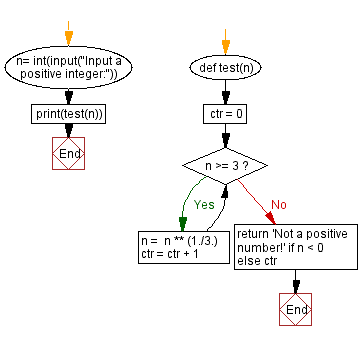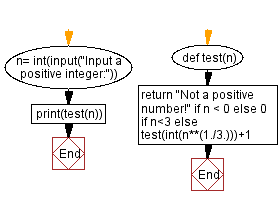Python Exercises: Iterated Cube Root
Cube Root Reduction Steps
Write a Python program that takes a positive integer and calculates the cube root of the number until the number is less than three. Count the number of steps to complete the task.
Sample Data:
(3) -> 1
(39) -> 2
(10000) -> 2
Sample Solution-1:
Python Code:
# Function to count the number of times a positive integer can be cubed until it is less than 3.
def test(n):
# Counter variable initialized to 0.
ctr = 0
# Loop continues until n is greater than or equal to 3.
while n >= 3:
# Cube root of n is calculated using the expression n ** (1./3.).
n = n ** (1./3.)
# Increment the counter by 1 for each iteration.
ctr = ctr + 1
# Return 'Not a positive number!' if the final value of n is negative, otherwise, return the counter value.
return 'Not a positive number!' if n < 0 else ctr
# Take user input for a positive integer.
n = int(input("Input a positive integer:"))
# Call the test function with the user-input value of n and print the result.
print(test(n))
Sample Output:
Input a positive integer: 3 1 Input a positive integer: 39 2 Input a positive integer: 10000 2 Input a positive integer: -4 Not a positive number!
Explanation:
Here is a breakdown of the above Python code:
- Function definition:
- def test(n):: Defines a function named "test()" that takes a positive integer 'n' as input.
- Counter Initialization:
- ctr = 0: Initializes a counter variable to 0.
- While Loop:
- while n >= 3:: A while loop that continues as long as the value of n is greater than or equal to 3.
- Cube root calculation:
- n = n (1./3.): Calculates the cube root of n using the expression n (1./3.).
- Counter Increment:
- ctr = ctr + 1: Increments the counter by 1 for each iteration of the loop.
- Return statement:
- return 'Not a positive number!' if n < 0 else ctr: Returns 'Not a positive number!' if the final value of 'n' is negative; otherwise, returns the counter value.
- User input:
- n = int(input("Input a positive integer:")): Takes user input for a positive integer.
- Function call and print:
- print(test(n)): Calls the "test()" function with the user-input value of 'n' and prints the result.
Flowchart:

Sample Solution-2:
Python Code:
# Recursive function to count the number of times a positive integer can be cubed until it is less than 3.
def test(n):
# Return "Not a positive number!" if n is negative.
if n < 0:
return "Not a positive number!"
# Return 0 if n is less than 3.
elif n < 3:
return 0
# Recursive call to test function with the cube root of n, and add 1 to the result.
else:
return test(int(n ** (1./3.))) + 1
# Take user input for a positive integer.
n = int(input("Input a positive integer:"))
# Call the test function with the user-input value of n and print the result.
print(test(n))
Sample Output:
Input a positive integer: 14 1 Input a positive integer: -5 Not a positive number!
Explanation:
Here is a breakdown of the above Python code:
- Function definition:
- def test(n):: Defines a recursive function named "test()" that takes a positive integer n as input.
- Conditional statements:
- if n < 0:: Checks if 'n' is negative and returns "Not a positive number!" in that case.
- elif n < 3:: Checks if 'n' is less than 3 and returns 0 in that case.
- Recursive call:
- return test(int(n ** (1./3.))) + 1: Recursively calls the "test()" function with the cube root of n and adds 1 to the result.
- User input:
- n = int(input("Input a positive integer:")): Takes user input for a positive integer.
- Function Call and Print:
- print(test(n)): Calls the "test()" function with the user-input value of 'n' and prints the result.
Flowchart:

For more Practice: Solve these Related Problems:
- Write a Python program to repeatedly take the cube root of a number until the result is less than three, counting the steps.
- Write a Python program to implement a loop that computes the cube root of an integer until the result falls below three, and count the iterations.
- Write a Python program to reduce a number by taking its cube root repeatedly until it becomes less than three, outputting the step count.
- Write a Python program to calculate how many cube root operations are needed for a number to drop below three.
Go to:
Previous: N x N square consisting only of the integer N
Next: Python String Exercise Home.
Python Code Editor:
Have another way to solve this solution? Contribute your code (and comments) through Disqus.
What is the difficulty level of this exercise?
Test your Programming skills with w3resource's quiz.
